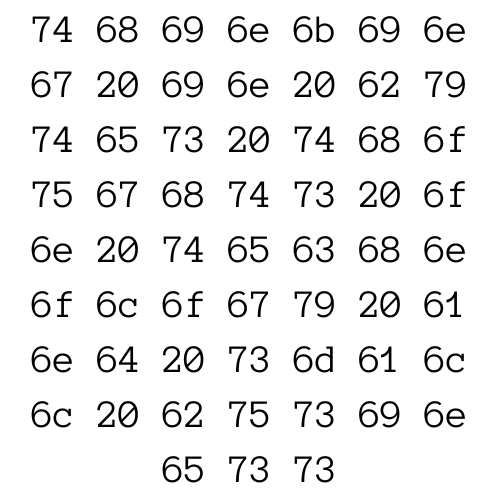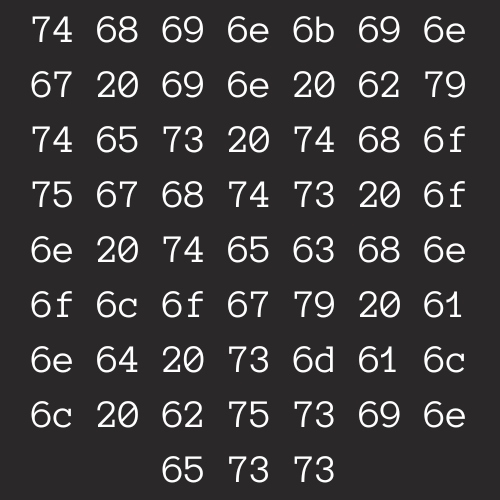A Piecewise Hashing Example
- The Problem
- Cryptographic Hashing
- What Is Piecewise Hashing
- The Obvious Weakness
- Final Thoughts
- References
NOTE: ChatGPT was used to create some portions of the code in this article. The words are mine.
The Problem
When cybersecurity analysts find malicious files, they share their finding with the greater security community. They run the file through a cryptographic hashing function and share the results of this function, called a hash. The hash is a kind of fingerprint that identifies the file based on the information contained in the file. Others can look through their environments, hash their files, and compare the results to hunt for the malicious file.
To make life difficult for defenders, the bad guys change a small part of their malware. It doesn’t take much. Adding whitespace or a comment alters the file, which changes the hash. Even though the malware functions the same, the signature used to detect it changes.
Cryptographic Hashing
A full explanation of cryptographic hashing is outside the scope of this post. Wikipedia has an article that describes the properties of a cryptographic hash function.1
What Is Piecewise Hashing
Piecewise hashing is hashing different pieces of the file. By comparing the hashes from chunks of the file, we can identify identical sections. To create a simple example, a string is used in place of a file. The process of piecewise hashing is the same whether it is a string of bytes or a binary file.
Take the following byte strings in python:
first_file = b"The rain in Spain falls mainly on the plain."
second_file = b"The rain in Spain falls mostly on the plain."
This string first_file is 44 bytes long.
The string second_file is 44 bytes long.
Hashing the strings shows their different fingerprints.
import hashlib
first_hash = hashlib.md5(first_file).hexdigest()
second_hash = hashlib.md5(second_file).hexdigest()
Printing both hashes shows the difference between them.
>>> first_hash
'3948716d567532d9aee33c7d2f34b970'
>>> second_hash
'33af9610767a566786f205bc2798d0c9'
Piecewise hashing can help us determine if any parts of first_file and second_file are the same.
First, we need a function to take a string and hash every 8 bytes.
import hashlib
from collections import OrderedDict
def hash_byte_sections(byte_data, BLOCK_SIZE=8):
"""
Takes a byte string or bytearray, hashes every BLOCK_SIZE bytes using the SHA1 algorithm,
and stores the hashes in an ordered dictionary.
Parameters:
- byte_data: The byte string or bytearray to be processed.
- BLOCK_SIZE: The size of the blocks to hash, default is 8 bytes.
Returns:
- An OrderedDict where each key is a tuple indicating the byte section (start, end)
and each value is the corresponding SHA1 hash of that section.
"""
if isinstance(byte_data, bytearray):
byte_data = bytes(byte_data)
hash_dict = OrderedDict()
for i in range(0, len(byte_data), BLOCK_SIZE):
section = byte_data[i:i+BLOCK_SIZE]
hash_value = hashlib.md5(section).hexdigest()
hash_dict[(i, i+BLOCK_SIZE)] = hash_value
return hash_dict
Before the hashing begins, we should understand what will be hashed. By printing the blocks for both byte strings, it is easy to see which blocks should have the same hash.
>>> for i in range(0, len(first_file), 8):
... section = first_file[i:i+8]
... print(f'BlockID:{i} {section}')
...
BlockID:0 b'The rain'
BlockID:8 b' in Spai'
BlockID:16 b'n falls '
BlockID:24 b'mainly o'
BlockID:32 b'n the pl'
BlockID:40 b'ain.'
>>>
>>>
>>> for i in range(0, len(second_file), 8):
... section = second_file[i:i+8]
... print(f'BlockID:{i} {section}')
...
BlockID:0 b'The rain'
BlockID:8 b' in Spai'
BlockID:16 b'n falls '
BlockID:24 b'mostly o'
BlockID:32 b'n the pl'
BlockID:40 b'ain.'
>>>
Based on the pieces of each string, BlockID:24 should yield different hashes.
Here is a comparison of the hashes:
┏━━━━━━━━━━┳━━━━━━━━━━━━━━━━━━━━━━━━━━━━━━━━━━━━━━━━━━┳━━━━━━━━━━━━━━━━━━━━━━━━━━━━━━━━━━━━━━━━━━┓
┃ Section ┃ Hash 1 ┃ Hash 2 ┃
┡━━━━━━━━━━╇━━━━━━━━━━━━━━━━━━━━━━━━━━━━━━━━━━━━━━━━━━╇━━━━━━━━━━━━━━━━━━━━━━━━━━━━━━━━━━━━━━━━━━┩
│ (0, 8) │ 282ecfc53331f9f3ca62d8fcce43f5aab2e3fc97 │ 282ecfc53331f9f3ca62d8fcce43f5aab2e3fc97 │
│ (8, 16) │ 114692ba9e0ead94834be6e9fd72392712362261 │ 114692ba9e0ead94834be6e9fd72392712362261 │
│ (16, 24) │ 34e9ff1e4013fcc34f53db23cc3f73983416503d │ 34e9ff1e4013fcc34f53db23cc3f73983416503d │
│ (24, 32) │ d3f243aad4a102497838ed4192fe5a1b281c110e │ 934957ccae2e3daccdce860342d9c230d1eb9fa5 │
│ (32, 40) │ dc445c795e8059532276b06d48889202066f62fc │ dc445c795e8059532276b06d48889202066f62fc │
│ (40, 48) │ 940998818acf17d7bdf93273d29f2004dbaefa37 │ 940998818acf17d7bdf93273d29f2004dbaefa37 │
└──────────┴──────────────────────────────────────────┴──────────────────────────────────────────┘
The Obvious Weakness
There is an obvious weakness with piecewise hashing based on a block size. Any new data added skews the sections and no hashes will match.
In our example, if second_file was changed to:
second_file = b"Yo! The rain in Spain falls mostly on the plain."
Every block is different from first_file.
>>> for i in range(0, len(second_file), 8):
... section = second_file[i:i+8]
... print(f'BlockID:{i} {section}')
...
BlockID:0 b'Yo! The '
BlockID:8 b'rain in '
BlockID:16 b'Spain fa'
BlockID:24 b'lls most'
BlockID:32 b'ly on th'
BlockID:40 b'e plain.'
And if none of the blocks contains identical data, no hashes will match.
┏━━━━━━━━━━┳━━━━━━━━━━━━━━━━━━━━━━━━━━━━━━━━━━━━━━━━━━┳━━━━━━━━━━━━━━━━━━━━━━━━━━━━━━━━━━━━━━━━━━┓
┃ Section ┃ Hash 1 ┃ Hash 2 ┃
┡━━━━━━━━━━╇━━━━━━━━━━━━━━━━━━━━━━━━━━━━━━━━━━━━━━━━━━╇━━━━━━━━━━━━━━━━━━━━━━━━━━━━━━━━━━━━━━━━━━┩
│ (0, 8) │ 282ecfc53331f9f3ca62d8fcce43f5aab2e3fc97 │ bdebd188ba898ee015353929760915df70ba2680 │
│ (8, 16) │ 114692ba9e0ead94834be6e9fd72392712362261 │ bcf704412b3b2a54aabeec0808f7121095591462 │
│ (16, 24) │ 34e9ff1e4013fcc34f53db23cc3f73983416503d │ 5acf81033c8b4aa7b0b8c7faca26ce82715e5239 │
│ (24, 32) │ d3f243aad4a102497838ed4192fe5a1b281c110e │ 7191da4765df51a1fd5eada0d5ac3a5c0c4eb491 │
│ (32, 40) │ dc445c795e8059532276b06d48889202066f62fc │ 54bfba16f6e9ee060e0ad6f1f9453f5afd0b197c │
│ (40, 48) │ 940998818acf17d7bdf93273d29f2004dbaefa37 │ 4271afeb901e39256c30d5419ad07e4726451698 │
└──────────┴──────────────────────────────────────────┴──────────────────────────────────────────┘
This makes piecewise hashing ineffective at determining if any part of the two files (strings in the example) are similar.
Even if we compared any first_file hash to any second_file hash, there are no matches.
Final Thoughts
This article was more about satisfying my curiosity with creating a simple piecewise hashing script in python. Software exist that perform fuzzy matching of files2 like the example presented here. The ssdeep project uses a different method of piecewise hashing called Context Triggered Piecewise Hashing (CTPH).3 A simple example of CTPH using python is a topic for another article.
References
-
Wikipedia article on cryptographic hash functions. ↩︎
-
Digital Investigations Journal article by Jesse Kornblum; September 2006 ↩︎

